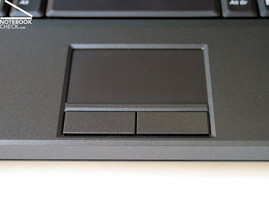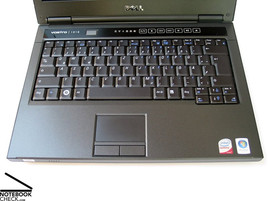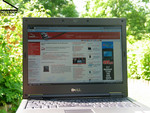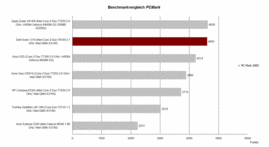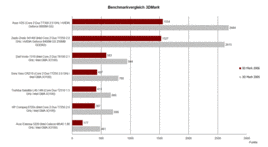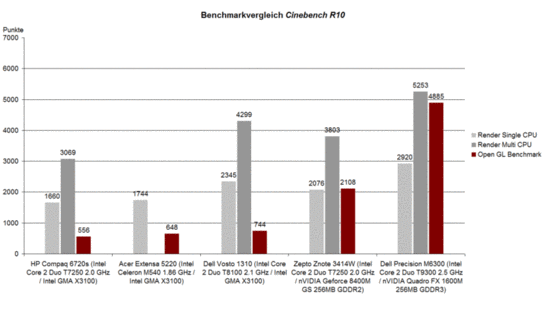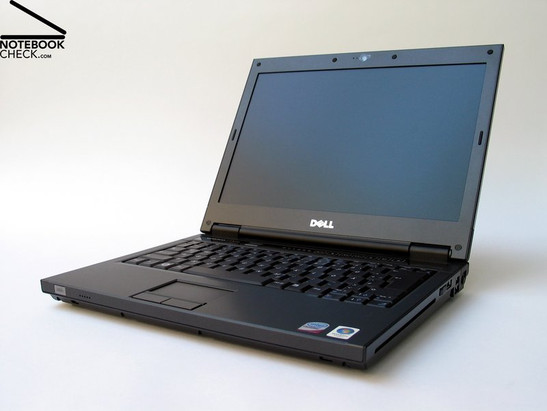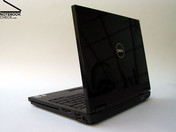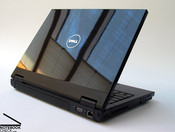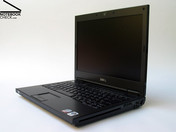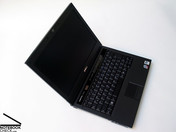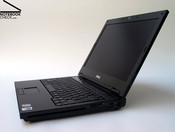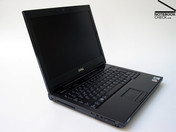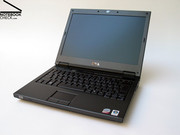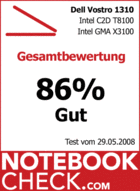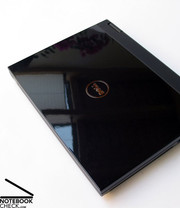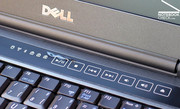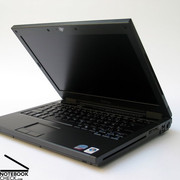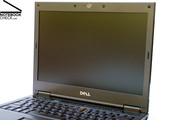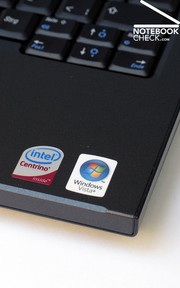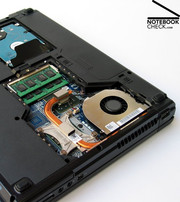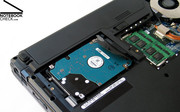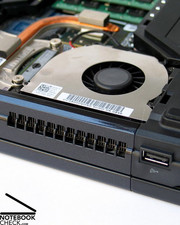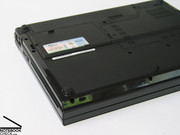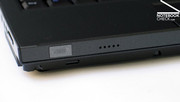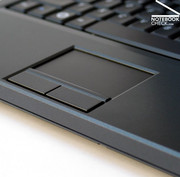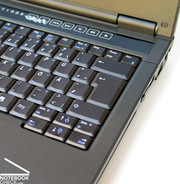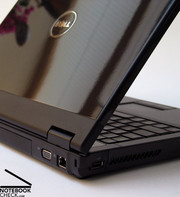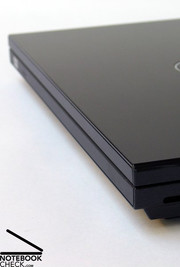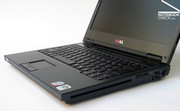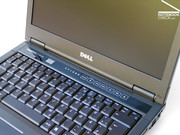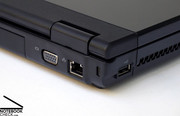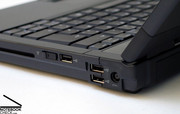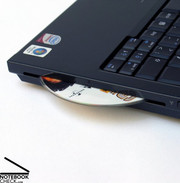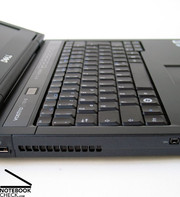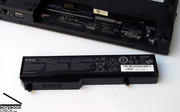Review Dell Vostro 1310 Notebook
Mobile Business.
Dell's Vostro series offers robust business qualities at a fair price and is thus interesting for customers who appreciate a stable and durable product. The Dell Vostro 1310 mainly impresses by its good mobility, which it achieves with a compact case, long battery life, and an outdoor capable display.
Dell still strictly distinguishes between private and business customers on its homepage. Private customers are apparently supposed to only buy Inspiron and XPS notebooks. This is a pity, since Dell's business section contains some very interesting models as well.
The Vostro series is Dell's business entry level category, which attracts by a very low starting price. For example, all it takes to get a Dell Vostro 1310 in its base version is 349.- Euro. However, the tempting customization options let the price quickly grow. The price for a Dell Vostro 1310 with the same configuration as our test sample is thus currently around 650.- Euro. A noticeable increase, but, considering what one gets for the money, it is still an excellent offer in our opinion.
Case
Like its predecessors (Vostro 1400, Vostro 1500), Dell's new Vostro series presents itself entirely in black. It seems the most important thing for business notebooks is to be unobtrusive. In this context, one could interpret the glossy display lid as almost daring, since this is usually the design choice for chic consumer notebooks.
Such a surface is rather unusual for a mobile business notebook, which emphasises stability and durability. It does not seem to be sufficiently durable for mobile use, because scratches quickly accumulate on the glossy surface, if it is frequently packed. Furthermore, it is also sensitive to fingerprints.
Compared with the previous Vostro design, the Vostro 1310 also significantly changed its shape without having an impact on handling it. But, we noticed a small yet annoying detail: The front edge of the notebook was slightly chamfered in order to improve ergonomics. Actually a good idea, but unfortunately the edge is too sharp now and rubs into ones arms during typing. Ambitious craftsmen (and women) use some fine grained sand paper to solve the problem within minutes. Apart from this problem and a few slightly uneven parts, the Vostro 1310's workmanship is pretty good.
Especially parts made of a magnesium alloy have a very positive effect on the overall case stability and feel nice to the touch. The base unit is resistant to point pressure. Hardly any creaky noises are noticeable while handling the notebook. The display and its hinges impress by stability as well. The latter support the position of the display without much wobbling. However, a transport hook is not available.
Interface Equipment
The interfaces of the Dell Vostro 1310 are spread around the entire case. Not surprising for a notebook of this category, a digital video out is not provided. Basically the Vostro 1310 provides only the ports typical for its category, but in a user-friendly order.
The front is free of interfaces. An ExpressCard slot is located at the left side close to the front. It allows expanding the notebook by various compatible cards. However, the ejecting mechanism is very annoying: You need to push the eject button in very deep in order to get rid of the plastic dummy.
Directly above are a CardReader, and 3.5mm headphones and microphone jacks. A FireWire port is located next to them. Behind the vent holes there is one USB 2.0 port.
The battery is on the back side. Our test sample was equipped with the alternative and larger 56Wh battery, which doesn't, unlike the bigger batteries of competitor notebook, project over the case. An analog VGA interface, which allows connecting an external screen or beamer, is located right of the battery. Immediately next to it are the LAN port (Realtek Gigabit LAN) and a Kensington lock.
The right side of the notebook contains a slot-in DVD drive (Teak DVW28SLC), which needs only about half the space. Next to it is a hardware switch to deactivate the WLAN module (Intel 4965AGN) and Bluetooth. Further back are another three USB ports. So, a total of four USB ports are available. This is more than its direct competitors have. The power connector is on the right side close to the back as well.
Equipped with Gigabit LAN and WLAN Standard-n the Dell Vostro 1310 comes with the currently fastest wired network connection and the fastest wireless one. Additionally, it is possible to add an integrated Bluetooth module for 25.- Euro extra.
A fingerprint reader was not available, but, according to Dell it is an option. Furthermore, the notebook contains a TPM 1.2 chip. Another feature which protects your data is an integrated free fall sensor, but only the offered 7200 rpm hard disks have such.
Free accessories are not included in the Dell Vostro 1310's shipment box. Dell offers various options in its on-line ship, e.g., carrying bag, mouse, or keyboard, but obviously for extra cost.
A similar system is in place for the warranty. The standard package offers only 12 months base warranty. With some extra cash (149.- Euro Basic On-Site service) it is possible to extend it to a maximum of three years support. Compared with competitors this is an acceptable offer.
Input Devices
Dell managed to put a generously sized keyboard into the Vostro 1310, despite the compact 13.3" case. The 18 x 18 millimeter large keys make this clear immediately. A two row Enter key and a properly sized, as well as centrally placed space key further improve typing comfort. Only the cursor and function keys were reduced a bit.
The layout of the Vostro 1310's keyboard doesen't offer any surprises, which is fortunate. All keys can be hit intuitively, including the control key on the left bottom and the delete key on the right top. The keyboard also impresses with a very good typing feel, which comes mainly from the very even and pleasant resistance from each key and a clear pressure point. Typing noise during normal usage is limited to a discreet clicking.
The touch pad convinces with a pleasant surface, but it sits a bit too low in the case, which leads to constant contact between finger and border.The two touch pad keys have to be pressed deeply, which is typical for Dell notebooks. Whether this is good or not depends a lot on personal taste.
Outstanding are the touch sensitive hot keys of the Dell Vostro 1310 above the keyboard, which enable media player functions, control sound volume, and let the user eject discs from the optical Slot-In drive.
Display
A 13.3" WXGA display is built-in the Vostro 1310, which supports a maximum resolution of 1280x800 pixel. The user can choose between a TrueLife screen with glossy surface and a matte display. Our test sample had the non-reflecting display, which is preferable to the TrueLife version, if the notebook is mainly used for office work.
The 13.3" WXGA display managed to score high in the brightness test. A maximum of 238cd/m2 was measured in the center of the display. Also noticeable was the brightness drop towards the corners of the screen down to a minimum of 181.2cd/m2, which results in an average illumination of only 76.1%.
| |||||||||||||||||||||||||
Brightness Distribution: 76 %
Contrast: 162:1 (Black: 1.47 cd/m²)
Not exactly great is the contrast of the display. A black value of 1.47cd/m2 means the display has a maximum contrast ratio of only 162:1, a rather modest result. The image seems subjectively a bit bland, which is probably due to the below average contrast. A slight rest brightness is noticeable, even with an entirely black background.
An average brightness of 201cd/m2 and a matte surface that doesen't reflect much , gives hope regarding outdoor use of the Vostro 1310. The practical test validates this assumption. Even in sunshine and on batteries, which means an equal maximum brightness everywhere on the screen, the Dell Vostro 1310 offers a well readable image at all times and is thus suitable for outdoor work.
Viewing angle stability on the other hand, leaves room for improvement. While the image stays fairly constant if the horizontal viewing angle gets flatter, until it reaches a point where the contrast drops quickly, it is not very forgiving in vertical direction. Even small deviations from the optimal viewing angle cause significant changes in the image and end in a rapid darkening of the screen. This means frequent adjustments of the display to get a proper image, especially during mobile usage.
Video viewing angle stability of the display
Performance
Dell allows a variety of possible configurations for the Vostro 1310 regarding processor, graphics card, RAM and hard disk. The entry level processor is the Celeron 540 single core CPU with 1.86GHz. From there it goes up to the already slightly older Merom dual core models up to current Penryn models made by Intel. All models starting from T8100 up to the T9500 CPU are available to the user.
Our test sample was equipped with a T8100 processor, which offers a compromise between very cheap but weak Celeron CPU and faster but significantly more expensive T9xxx Penryn processor with 6MB L2-cache (cost increase T9300: 270.-, T9500: 550.- Euro).
The T8100 has a clock rate of 2.1GHz and 3MB L2-cache. Although the T8100 is behind other Penryn models in terms of performance, it still offers better performance than Intel's Merom processors with identical clock rate.
The next difficult decision is the graphics card choice for the Dell Vostro 1310. Either an integrated Intel X3100 graphics chip or a dedicated Geforce 8400M GS graphics card made by nVIDIA with 128MB video memory.
As long as the notebook is only used for office applications, internet, DVD replay, and similar tasks, while being kept away from current games, the integrated graphics card is more than sufficient. The advantages are lower surface temperatures, a quieter fan, and a longer battery runtime, because the integrated graphics chip consumes less energy.
Our "medium-budget-office" configuration with T8100 processor and integrated Intel X3100 graphics achieved satisfactory results. For example, it managed a pretty good result of 4605 points in the PCMark 2005 benchmark test.
It can also easily keep up with similar notebooks in the 3DMark 2005/2006benchmark test.
The T8100 Penryn processor shows a good performance in the Cinebench R10 benchmark rendering test, but the integrated GMA X3100 graphics chip cannot impress in the shading (OpenGL) test.
It is thus wise to go with the dedicated nVIDIA graphics card if one plans to do performance intensive tasks like 3D animations, video editing, or gaming.
Our test sample contained 2048MB DDR2 PC5300 RAM. The maximum possible amount of RAM is 4096MB, but only a 64-bit operating system (Vista Ultimate 64) is actually able to use so much RAM. Dell also offers the Vostro series with Windows XP for those who don't want to switch to Vista.
Dell offers again a variety of hard disk choices. Apart from various 5400r/min models it is also possible to choose among some fast 7200r/min hard disks. Our test sample was equipped with a Toshiba MK1651GSY (7200) with 160GB space. The HDTune performance test showed good results for the hard disk regarding transfer rates and access rates, which had also a positive effect on the PCMark benchmark result.
| 3DMark 2001SE Standard | 3639 points | |
| 3DMark 03 Standard | 1808 points | |
| 3DMark 05 Standard | 944 points | |
| 3DMark 06 Standard Score | 583 points | |
Help | ||
| PCMark 05 Standard | 4605 points | |
Help | ||
| Cinebench R10 | |||
| Settings | Value | ||
| Shading 32Bit | 744 Points | ||
| Rendering Multiple CPUs 32Bit | 4299 Points | ||
| Rendering Single 32Bit | 2345 Points | ||
Emissions
Noise level
The not too powerful hardware targeted at office use has a very positive effect on the cooling system of the Dell Vostro 1310. In office mode with undemanding applications like word processing or internet and performance profile "balanced", the fan stays virtually always deactivated. With a measured noise level of only 31.0dB(A) the notebook is almost inaudible. Only the muted hard disk noise can be heard and the fan sometimes turns on for a couple of seconds during performance peaks .
Under constant load, for example during the benchmark tests or rendering tasks, the maximum noise level of the Vostro 1310 rises up to 38.2dB(A). But even this noise can still be described as acceptable.
Noise level
| Idle |
| 31 / 31 / 38.2 dB(A) |
| HDD |
| 32.1 dB(A) |
| DVD |
| 38.1 / dB(A) |
| Load |
| 36.5 / 38.2 dB(A) |
 | ||
30 dB silent 40 dB(A) audible 50 dB(A) loud |
||
min: | ||
Temperature
Not only the noise level, but also the surface temperature of the case profit from the hardware components. The top side of the base unit stays with maximal 33.9°C in the left area rather cool, while the bottom side modestly heats up to only 37.2°C.
The low surface temperatures are especially desirable during mobile use of the notebook, since one can safely place the device on one's lap without getting burned.
(+) The maximum temperature on the upper side is 33.9 °C / 93 F, compared to the average of 34.3 °C / 94 F, ranging from 21.2 to 62.5 °C for the class Office.
(+) The bottom heats up to a maximum of 37.2 °C / 99 F, compared to the average of 36.8 °C / 98 F
(+) The palmrests and touchpad are cooler than skin temperature with a maximum of 31.9 °C / 89.4 F and are therefore cool to the touch.
(-) The average temperature of the palmrest area of similar devices was 27.6 °C / 81.7 F (-4.3 °C / -7.7 F).
Loud speakers
Very minimalistic is the Dell Vostro 1310's sound and music replay. This is not surprising, since the only evidence that there are actually speakers respectively a speaker in the notebook are five small holes on the front edge of the notebook. These five holes emit not very loud music with little bass towards the user. At least the speaker manages to keep the sound quality, even if the volume is on maximum.
Battery runtime
Dell equipped the base version of the Vostro 1310 with a 4-cells, 38Wh main battery. A 58Wh model with 6-cells is available for 35.- Euro extra. Our test sample was equipped with that bigger battery, which fits as neatly as the 4-cell battery in the case and doesen't stand out at the back.
Apart from a lower price, one can also expect to have a bit lighter notebook with the small battery, but of course also significantly reduced battery life.
Equipped with a 58Wh battery , the Dell Vostro 1310 managed to impress during the battery runtime test. It managed a maximum battery life of 361 minutes respectively 6 hours in the BatteryEater Readers test, with maximum energy savings options and minimum display brightness, as well as deactivated WLAN and Bluetooth.
Under load in the BatteryEater classic test the Vostro 1310 managed with a bit more than 1.5 hours a still acceptable result.
The Vostro 1310 can also score in the practical battery runtime test. With Windows energy saving mode and maximum display brightness it plays DVDs for very good 148 minutes. Similarly impressive was the wireless LAN test (medium brightness, level 4/7, energy saving mode) with 250 minutes battery runtime.
| Off / Standby | |
| Idle | |
| Load |
|
Key:
min: | |
Verdict
Despite the very low entry level price of only 350.- Euro, but which can be much higher depending on the configuration, the Dell Vostro 1310 offers in the configuration of our test sample a very good show. The case with simple geometrical shapes, offers good stability due to parts made out of a magnesium alloy, which gives hope regarding durability. Only the glossy display lid doesen't quite fit into Dell's concept, since it makes ugly wear marks like fingerprints and scratches inevitable.
A positive surprise is the Vostro 1310's interfaces. Although it only includes standard ports like VGA, Firewire, and USB, the fact that the Vostro has four USB 2.0 ports , which are user friendly placed around the case with the other interfaces, makes up for it.
The input devices of the Vostro 1310 facilitate mobile office usage, and are pleasant and easy to use.
The Display impresses with a brightness of over 200cd/m2 and a matte, non-reflecting display surface. As a result, the screen content stays even in bright environments readable, which makes the notebook outdoor capable. Limiting are only the possible viewing angles of the display, since small deviations from the optimal angle cause the generally not very good contrast ratio to get worse quickly.
Performance of the Vostro 1310 depends a lot on what the user wants to do with the notebook. The available choices range from cheap Intel Celeron processor with integrated graphics card to powerful T9500 processor also by Intel, with nVIDIA Geforce 8400M GT dedicated graphics card for users with higher demands on performance. But no matter what the configuration, the Vostro 1310 is mainly built for office tasks.
Hardware targeted at office use gives the user the advantage of low noise level and temperatures , two important aspects that should be rated higher with compact and mobile notebooks.
Another aspect that profits from not having the fastest hardware is battery runtime. With the alternative 6-cell battery the Vostro manages up to six hours, which helps mobile use a lot.









